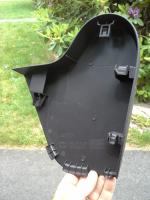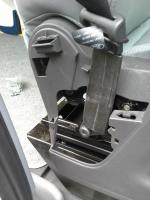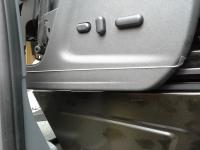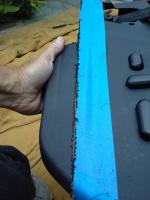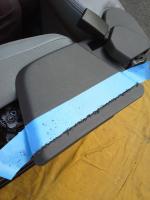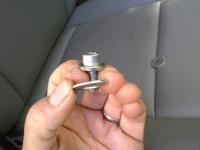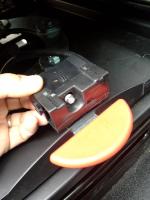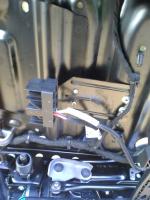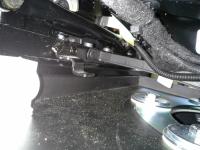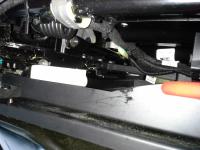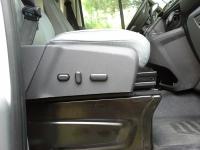Transit power-seat swivel installation
We installed our swivelsrus passenger-side swivel today (6/12/16), and our power seat can now swivel at even the lowest seat setting. Installation was pretty straightforward. I highly recommend Morey’s blog post for great pictures, and step-by-step instructions. We went a little further in allowing the swivel to rotate even when the seat is lowered, so that’s where I’ll concentrate here.
(A more complete overview of our conversion of our Ford Transit cargo van can be found here.)
Unpacking
The swivel arrived earlier this week from transitaccessories.com.
They pack it in styrofoam peanuts (who uses those anymore?), and they
don’t protect the product with a plastic bag. The result is that
peanuts get crammed into the channels and holes in the swivel, and
won’t come out with out breaking them into tiny pieces, which
exacerbates the static cling issue of the peanuts themselves by about
a thousand-fold. Half an hour of vacuuming the garage, the swivel,
and me, and all was back to normal.

(I’ve corresponded with transitaccessories about this – they seemed appreciative of the feedback, so hopefully packing will improve.)
Preliminary cuts
Our van has power seats. There’s an issue with the side skirts on the seat not letting the seat swivel unless you either a) shim the seat with a stack of washers (that’s what Morey did), or b) trim the plastic skirt as “dsheil” did. (Or c), transitaccessories.com will sell you a taller “kit” for a bunch more money. I certainly wasn’t going to do that.)
We started by doing the minimal possible cut to the outside skirt. This would at least let us swivel the seat while fully raised, and lower it to the bottom when aimed straight ahead or straight back. Here are some pictures of that operation. To do this, only the outer skirt, which is longer, needs to be cut.
(BTW, I recommend removing the seatbelt cover so you know what’s under there, but reinstall it while doing the cutting so that the whole side of the skirt gets a uniform cut. Remove the cover by pulling upward and outward – it’s just a snap fit.)
We first figured out where to cut with a piece of string (for easy adjustment), and then used a piece of tape as a final guide. Cutting was done with an oscillating multitool, with finish-up done with a hacksaw blade where necessary. The metal supporting bar needed to be cut through as well as the plastic – I confess I hate cutting metal with those oscillating tools, but it got through it eventually. The cuts in the plastic needed cleaning up with a coarse file, but they came out pretty straight – the long effective blade length on the oscillating tool helped a lot with that.
Final cuts
Once the seat could swivel at all, we immediately realized we were really going to want more: any swivel angle, at any height, without fear of squishing or damaging bits of the seat. As things were, the remaining lengths of skirt could collide with the seat base when swiveling or lowering, and we didn’t want to have to watch out for that all the time. So we made some more cuts – we didn’t need to touch the inside skirt the first time, but this time some of it would have to come off. More pictures, of both the new cuts…
First “gotcha”: washers
Morey pointed out in his blog that the washers that come with the swivel are too wide for their roll holding the lower seat rail, since the upper rail will hit the washer on its way past. I tried some smaller, but also thinner, washers, but they bent when tightened: they didn’t fit the bolt well enough, and the holes the bolts go through are pretty big.
I was able to get some thicker 1/8” washers (shown above), 3/4” OD and 1/4” ID at the hardware store. They were in the “Grade 8” drawer. Those worked well, but since the fit of the rails to the seat base is sloppy, it’s still important to be sure the bolts are centered in the rail, otherwise you’ll still hear some scraping when the seat moves far enough forward. Tighten the bolts snugly, and use a screwdriver to pry the rail back and forth until the seat moves smoothly.
Second “gotcha”: no forward travel stop
Stopping the seat from moving too far forward is normally accomplished by a tab that’s welded on to the upper (moving) seat rail: it normally hits the motion-stop bolt, which is the size 45 Torx bolt that doesn’t appear to do anything, just to the inside of the fixed rail mount on the seat base.
But with the seat on the swivel, the front motion-stop bolts are no longer there to do their job – the seat will just keep on going forward. But! …
… if the seat is in its lowest position when it moves forward, you’ll have a worse problem before you ever get to that point. The electrical junction box (which is a big thing, mounted centrally under the seat) will collide with the red handle and its lever arm, both while traveling forward and then again when traveling back. You can damage the junction box, and bend its mounting arm before you even know what’s happening. (Don’t ask how I know.)
I added a couple of screws to the junction box’s arm, to help hold it closer up against the seat – that helped, but not enough.
Happily, it’s easy to fix this issue by inserted an appropriate block of wood, or plastic, such that it rests in the upper tray of the swivel, and stops the forward motion of the welded tab in time to keep the junction box from hitting the red-handled lever. These pictures aren’t great, but you can see the welded tab, and the white PVC block I fastened in place as a stop block. (I added a washer on the end the tab will hit, to distribute that load.) [ EDIT: See postscript below. Reversing the swivel on the base, so the handle is in the back, eliminates the clearance issue. ]
Final result
Here are pictures of the seat at both its lowest and highest settings, and swiveled a couple of ways at its lowest.
Postscript
We had a comfort problem with the seat swiveler – with a 28 or 29” inseam, and the amount the seat is forced up by the swiveler (1.75”), Julia had to have her lower legs go pretty much straight down (i.e., not stretched out) to get her feet fully on the floor. In that position, with the seat far enough back so that she could cross her legs when she wanted, the red handle was touching the back of her calves. I found it annoying as well, though I have the option of stretching out some more.
So, since someone else on the Ford Transit forum had already mentioned doing it, I reversed the seat swiveler, so the handle is on the back instead of the front. It’s now easier to use, has no clearance issues when run all the way forward or backward, and the red handle is out of the way of our calves. Win, win, win. To be clear: after reversing the swivel, the stop block was no longer necessary, and there’s no interference between the swivel mechanism and anything on the bottom of the seat. There is one small downside to the reversal: it’s no longer possible to rotate the seat without opening the door a few inches. Not a big deal.
